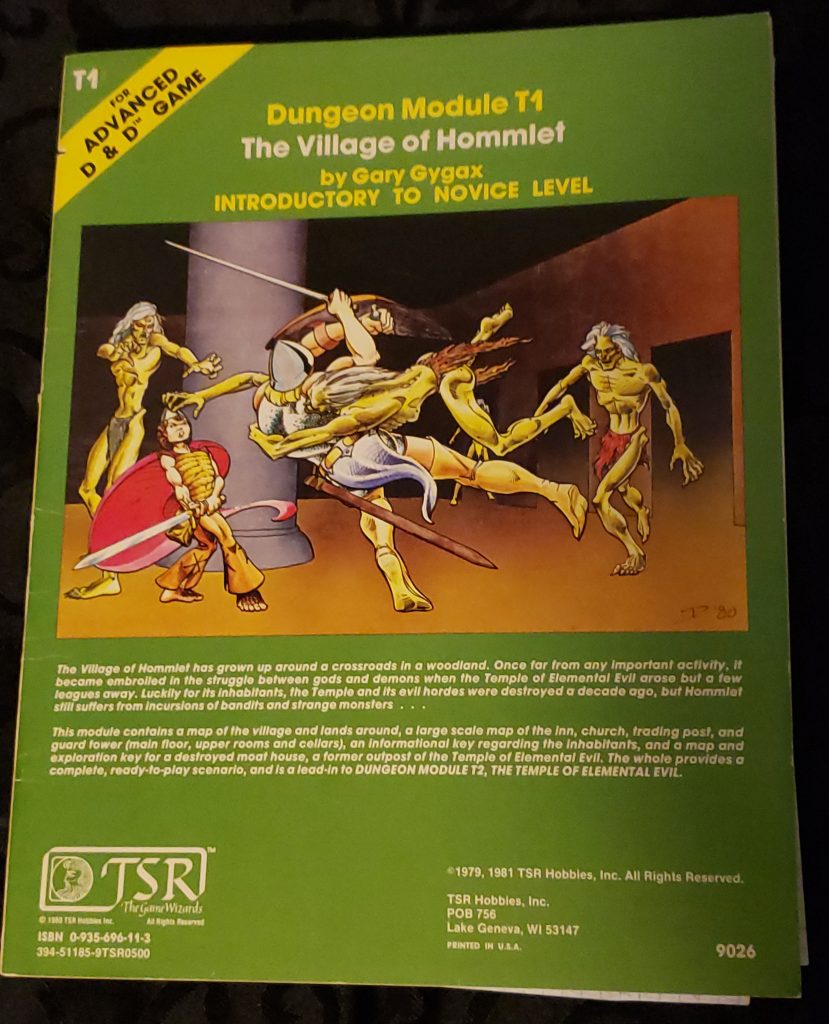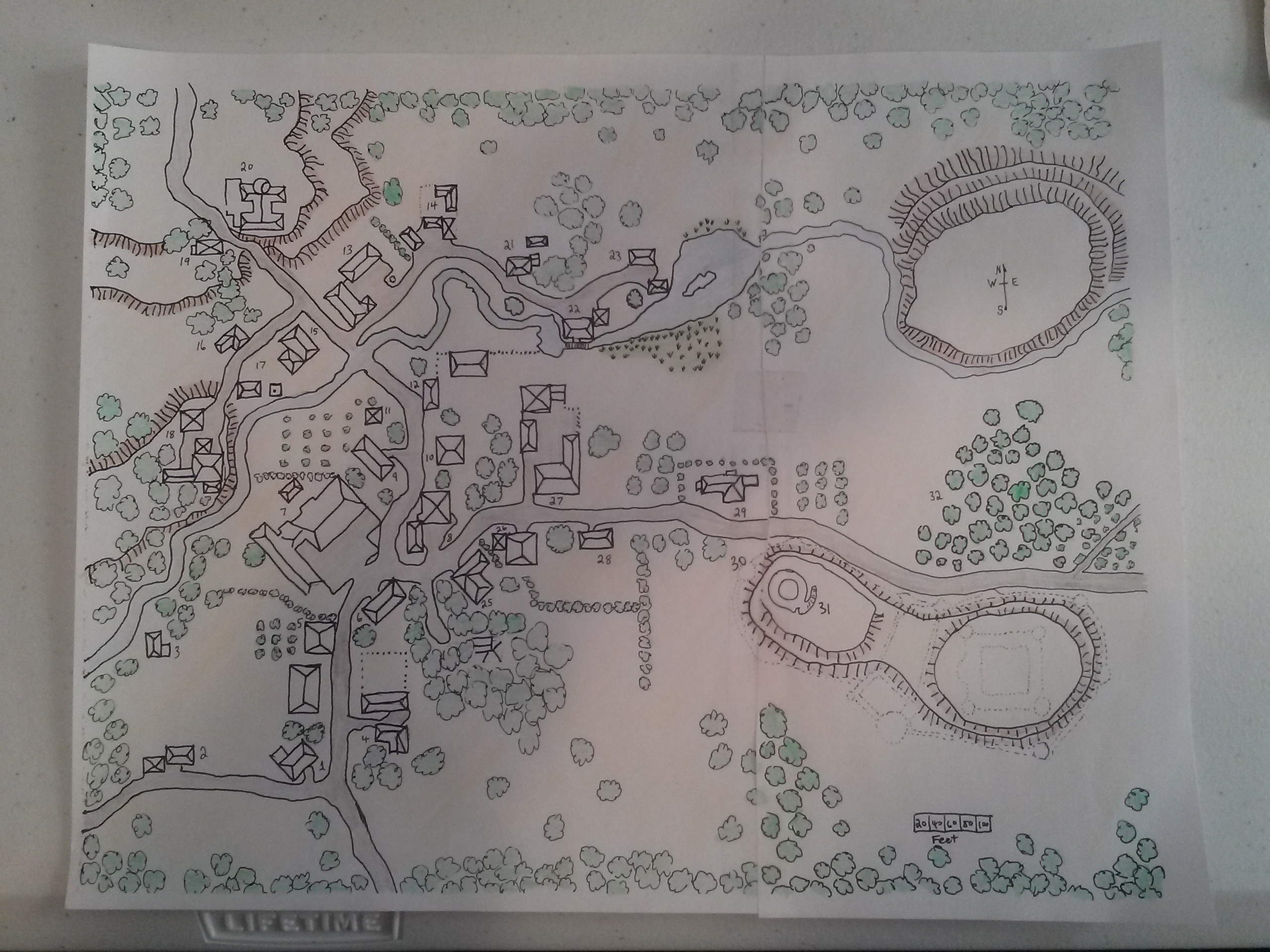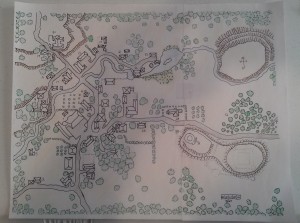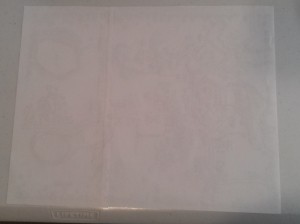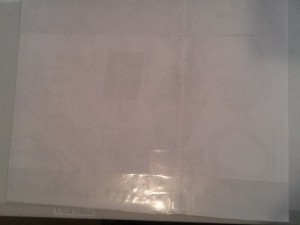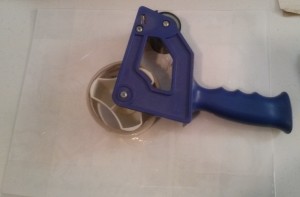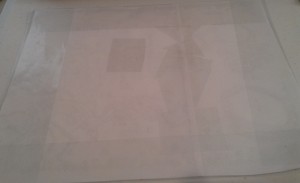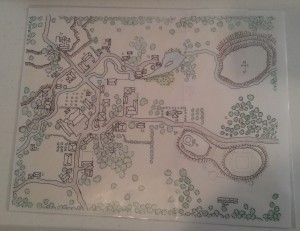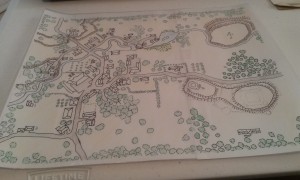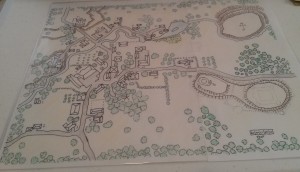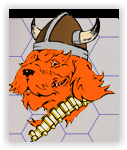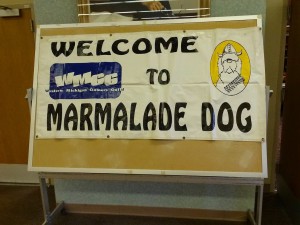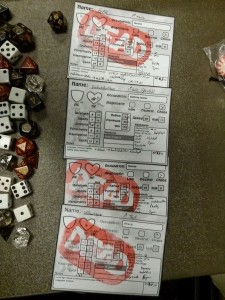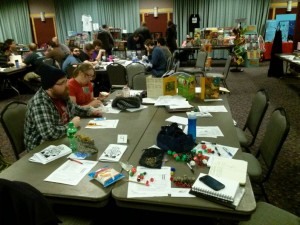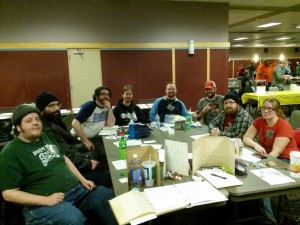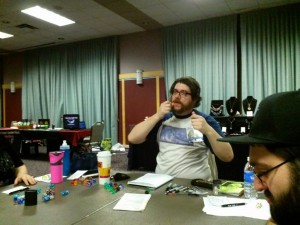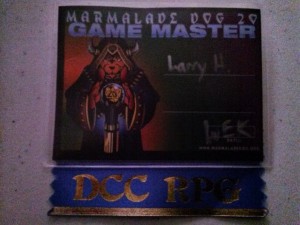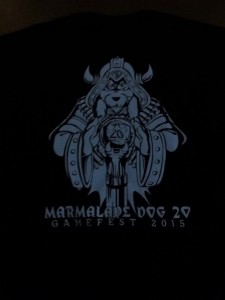UCon 2019 ended on Sunday, November 24 and I am finally writing about what happened. I mentioned what was on my schedule in my last post.
Pick Up Games
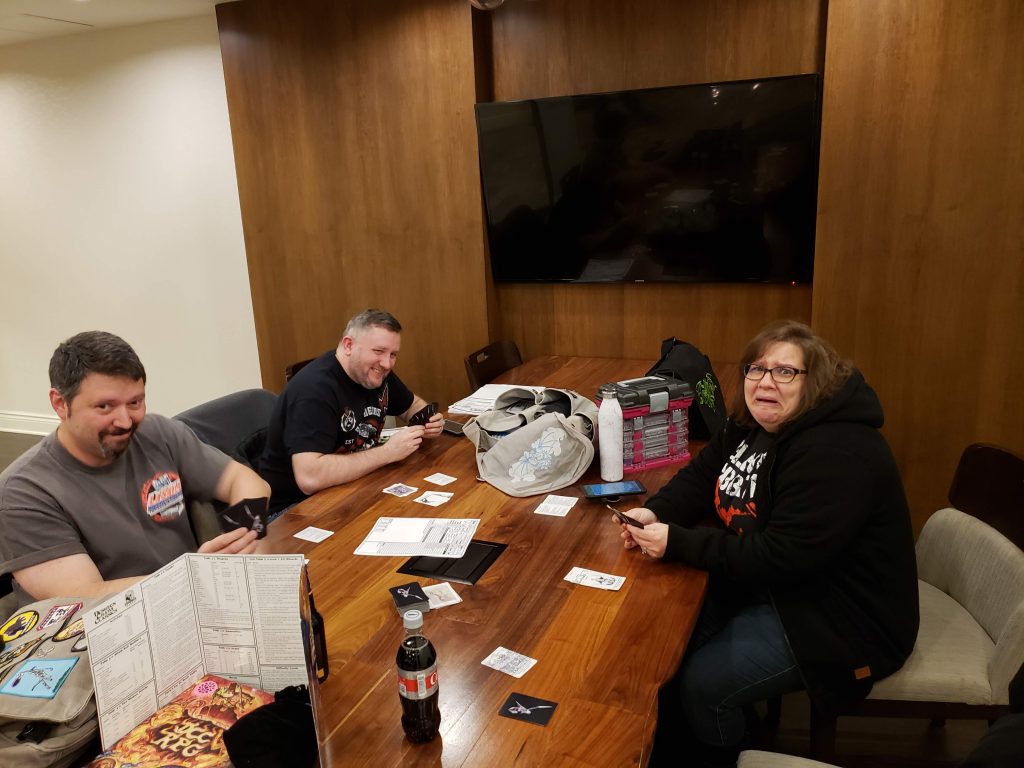
I met up with friends Thursday night and we had a pick up game of my card game. Laura Pirkola and Clayton Williams invited me to join in a pick up DCC [Affiliate Link] game with Brendan LaSalle. It had a hard start time so we didn’t get through the full card game as we had many interruptions. The most important of which was ordering a pizza. This was critical as I got so busy with packing and so forth before the two hour drive, that I didn’t have lunch.
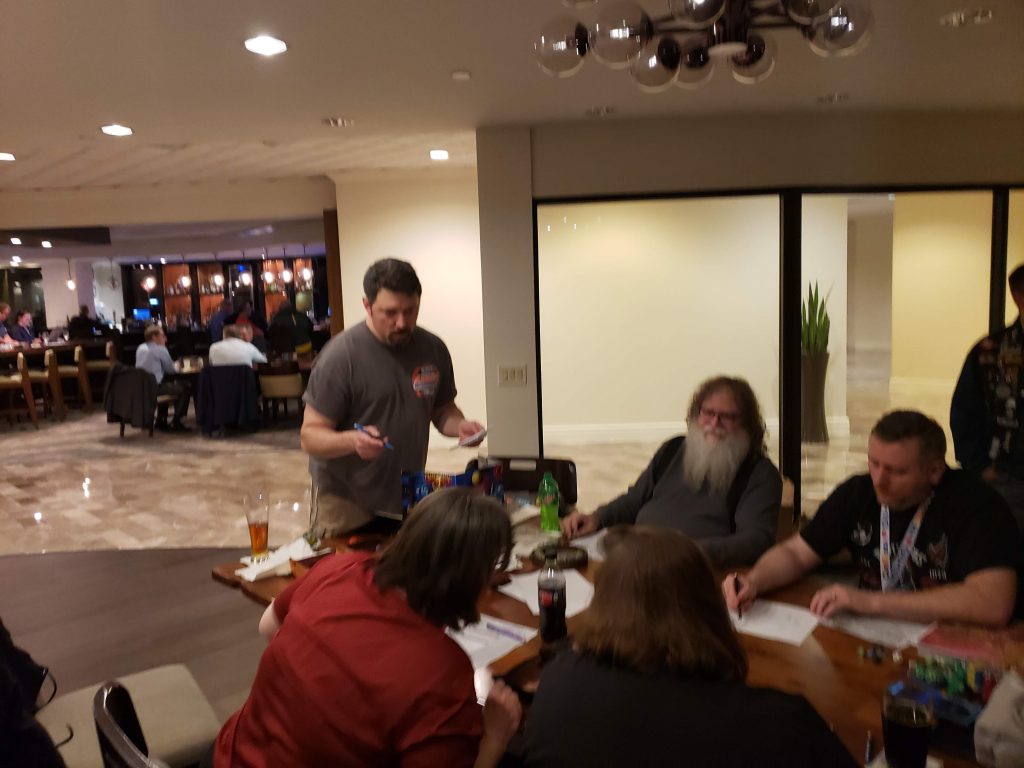
The DCC scenario was play testing something that should be appearing as a new module sometime in the future. I don’t recall if there was a specific time frame or not. We ended up playing two characters each, until we were joined by another husband and wife who joined in at the halfway point. It was a great time, as always with Brendan.
I stayed up way too late visiting with friends in the lounge. I didn’t get to my room until 2:30 AM, and took forever to fall asleep. Then I kept waking up. Part of the issue was being dehydrated as I hadn’t had enough water during the day, then had a tall glass in the bar, after a short glass during DCC and pizza.
Hommlet
I slept as long as I could before going down for breakfast before my morning game, where I ran Village of Hommlet [Affiliate Link]. I realized I had forgotten to grab my 1e DM screen when I packed up all my table copies of the Player’s Handbook. It seems I no longer had the PDF of the DMG [Affiliate Link] on my Dropbox nor my I got on my Google Drive. So I got on my DriveThruRPG account, since I purchased the PDF, I can just download it again…. NOT.
For some reason, I could not find it in my library. Next, I tried pulling up the PDF on its listing. Turns out I found a bug in the mobile site. On the desktop version of the website, you can click on the product listing for something you’ve already purchased, and it gives a link labeled, “Click to get it.” I got on Discord and mentioned it to the DriveThruDiscord and they said to report the issue, it’s probably a bug. [Which reminds me, I need to report it if it is still an issue after I finish this post.]
I only needed it for the combat charts. I then looked up the Target 20 System mechanic. When we were at the table, one of the players had the DMG on their tablet, so I used that to track combat, turning undead, etc. I planned on 8 players, but one person really wanted in, so we squeezed in nine players plus me around the table.
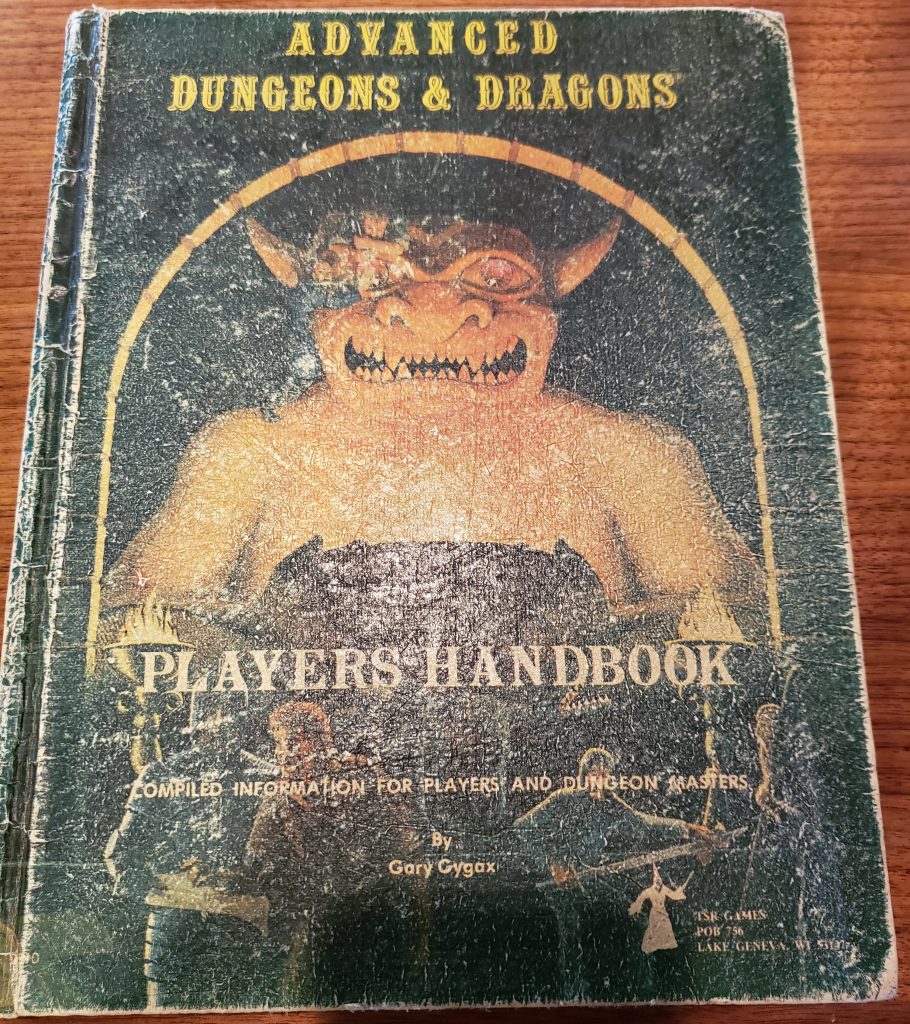
All of my other preparations were in place. I had five table copies of the Players Handbook [Affiliate Link] for players, plus my copy. I had them all sign my copy. This is the original, well-worn copy I got for Christmas back in the day. I’ve also gotten it signed by several TSR notables from back in the day. Sadly, not Gary or Dave.
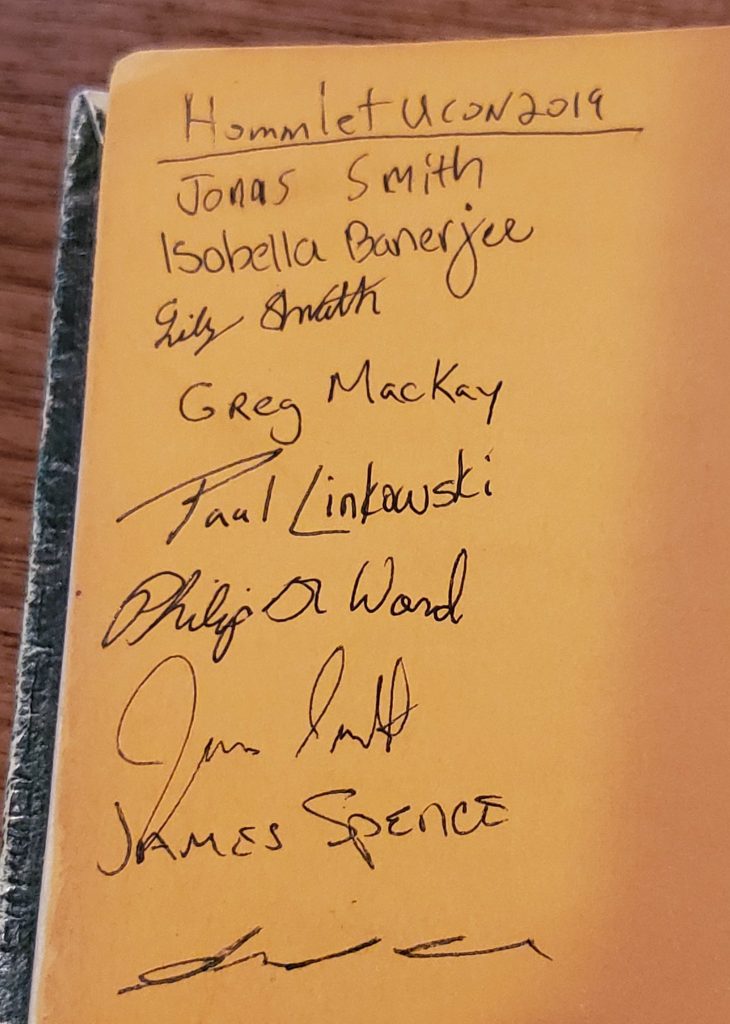
I also have 18 AD&D Characters I created. I have form-fillable PDF character sheets for each one, and I update their information for each level. So I always have a stock of characters for whatever AD&D adventure I run at a con.
The players had a great time. I started them at the gate house instead of making them start at the edge of town and figure out where to go. Most of my rolls were in the party’s favor. Things such as surprise, finding secret doors, etc. While they did not manage to find the big bad and his minions, they did find the ghouls and it was a near fought thing. The best fighters were getting paralyzed and they were just not hitting the ghouls. In the end, they bested the ghouls and we were out of time.
In the various instances of combat, some had been knocked down and I used the -10 HP is death in AD&D. They were stabilized and clerics were able to give them enough HP to have positive HP. I handle negative HP as serious and the player is unconscious for one hour per point of negative. This forces characters to be encumbered with an unconscious character, if they push on, or having to find a place to rest in relative safety. They were all experienced players and chose to hole up and rest each time players were incapacitated.
During the ghoul fight, several characters went into negative HP. They were pretty chewed up, but had find some nice treasure. I didn’t keep track, but I don’t think it would have been enough XP for 9 characters to level.
Boot Hill
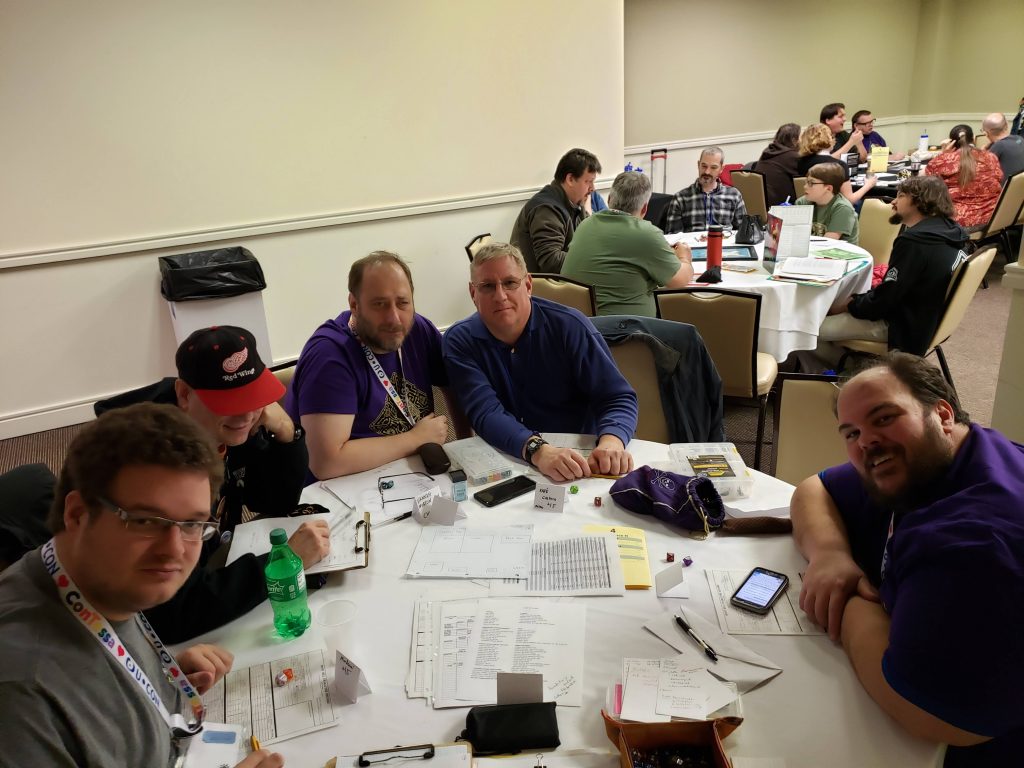
Last year, I ran a Boot Hill 2e [Affiliate Link] game, A Posse For The School Marm. All of the players asked for a sequel for next year. So I brought a sequel, Meanwhile, Back At The Ranch , that we played Friday night at the same table as Hommlet that morning.
Two of the players from last year made it, and brought their character sheets. The group played smart and rolled well. The rules for Boot Hill 2e [Affiliate Link] are very light. I realized I was not using an option that would have made the gunfights last longer. I made the big bad tough, but not fast enough. The players grabbed the pregens that had the fastest characters, which I forgot I rolled some really nice scores for the pregens. (Why can’t I roll that well for my own characters?)
We had a lot of fun and there were requests for another sequel, so I will have to scratch my head on that one. I didn’t have a ready made scenario like I did after last year.
I ended the day in the bar, but went to bed earlier. I was able to sleep in as I didn’t have my first scheduled game until 8:00 PM Saturday.
Macchiato Monsters
I slept in Saturday and got in on a game of Macchiato Monsters [Affiliate Link] ran by Brett Slocum. I had a play games all weekend pass, which makes it easy to slip into games with openings.
I had never played Macchiato Monsters [Affiliate Link] , but it is described as a cross between Black Hack [Affiliate Link] and White Hack. I’ve played Black Hack and have both 1st and 2nd edition. I’ve never seen nor played White Hack.
It has a great deal of freedom in character creation and requires players to be creative, as one chooses a self-defined character within the parameters set by character creation.
It was a fun time and a full table. We all played as a team and ended with a whirlwind wrap up by the GM, as there was more module than time would allow, but we got a feel for the rules. It is much more reliant on role play but dice do come into play. Creativity and an open mind are key. I’m definitely intrigued and will look into picking up both Macchiato Monsters [Affiliate Link] and White Hack.
NOTE: White Hack is only available on Lulu and does not have a PDF.
Playtesting The Card Game
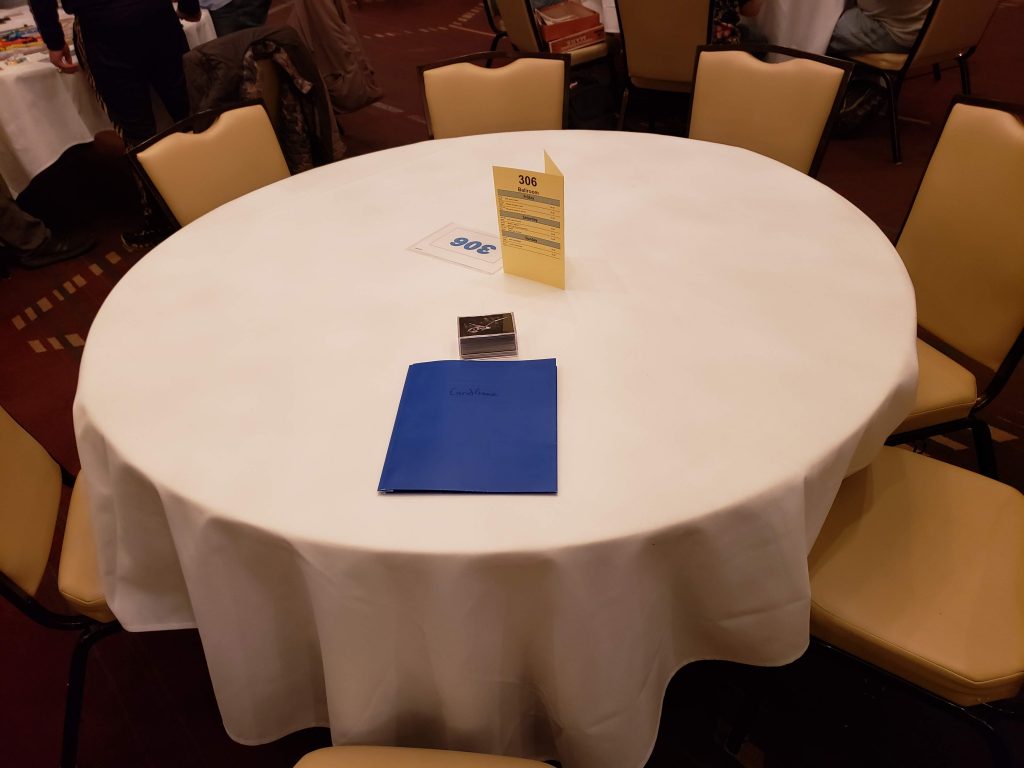
While I have had lots of playtesting of the card game at two game stores, two Gary Cons, two Marmalade Dogs, and now two UCons, this was the first time I had a playtest on the official schedule at a con. This was also the first time I had played in the board game area. I had strolled through it just to see what was going on in prior years.
I had one person pre-registered, and two other players for the first round of playtesting. One player, the youngest, in his 20’s left before the first hand was played. He went to join a game one of his friends was running. I had one person walking by who we invited to join the second game.
The consensus was that they all liked it, but felt it needs something more. The big thing is the game lasted nearly an hour. This is because the end condition for the game is dependent on how long it takes for a control card to come up twice. In this case, it was very late in both halves of the game.
While I understand the suggestions, it runs the risk of either breaking something that works, or making a very simple game more complex. It is interesting that about half the players who have played it, likes the rules as is, and the other half want something more.
I have some ideas for how to have two ways to play, a simple rules default and a full rules option.
In the current rules, each card does one thing. That is the strength of the rules. The challenge is to have additional rules and options for some cards that will not break the game or make it overly complicated.
I also honed my elevator pitch for the card game: Each player is building their own army in the midst of challenges. The player with the largest army (most points) wins.
All in all, I had great feedback from people who play a lot of games, and one of them also designs his own games. He had a WWII war in the Pacific naval simulation that I and another player from the playtest played after the time was up. It was a lot of fun and while it needs a bit of polish, I look forward to seeing it again next year.
The game developer player’s game partner stopped by midway through the WWII game and they are working on a space combat game that they have been playtesting at conventions for several years, including Gencon. They had a game slated for the next morning and invited me to join. I was very intrigued by their description.
[Earlier today I got the first piece of complete line art in preparation for the coming Kickstarter. I’ve got concept sketches for over a dozen cards, and hope to have many more soon.]
Space Combat Game
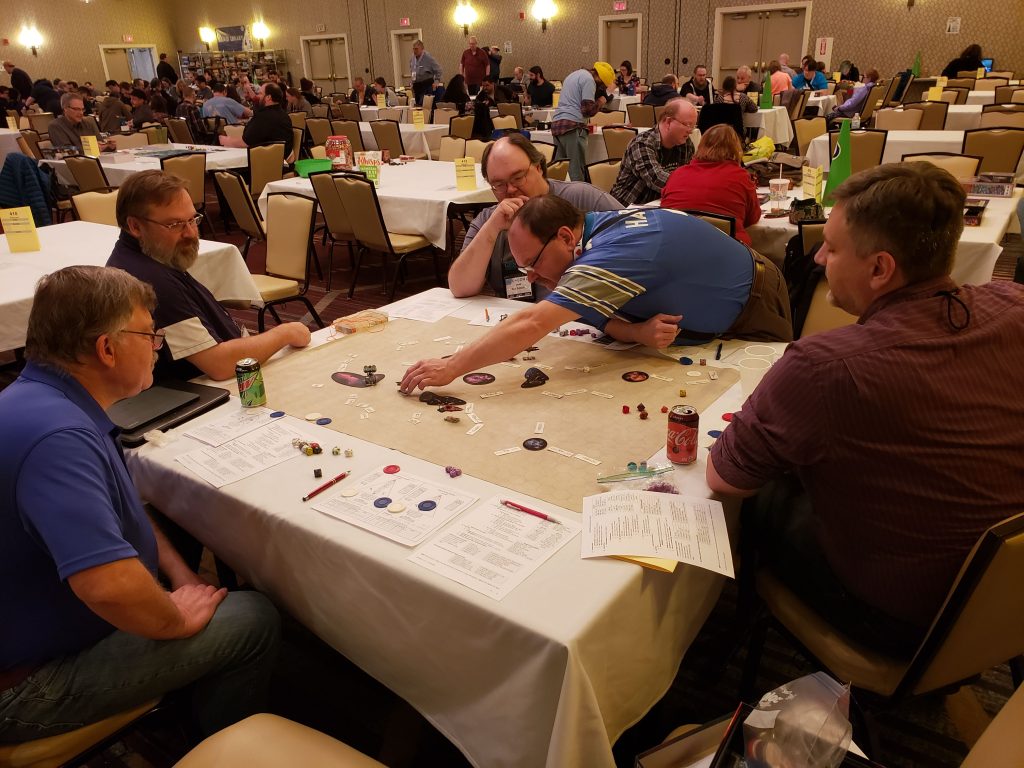
The name of the game is Star Blast. This was the last play test prior to publishing. Their plan it to put the rules on DriveThruRPG to get it out there, then do a Kickstarter to make a board game out of it.
They use Excel to make the ship sheets. Each ship has sensors, power, shields, weapons, etc. This very loosely reminds me of the original Star Fleet Battles from the mid 80s. I played a lot of Star Fleet Battles with my brother, Robert, and our friend Darryl.
Another player and I were space pirates out for resources. The other team represented the system with the resources. We had a railgun battle cruiser and a torpedo cruiser and a beam cruiser. They had a carrier with two fighter squadrons and a frigate. Our ships outclassed theirs.
We won almost all of the rolls to determine turn order. The first turn we elected to let the other team go first, so we could react to them. We then tried to move in and find a clear shot. There were lots of asteroids and gas clouds that limited the effectiveness of long shots.
I commanded the torpedo cruiser and beam cruiser. I moved to intercept and fired on their frigate and got a long range hit. Their carrier moved to a certain range and released fighters, then it got behind a gas cloud. The fighters and the frigate did some damage to one of the light cruisers, but damage control repaired it.
Our side focused on the fighters before they could get back to the carrier to get more torpedoes. We managed to hurt them a bit. Another few shots on the frigate and it had “fires”. Since a fire in space could easily be put out, it was explained that fire was shorthand for cascading system failures.
The damage control rules required a certain roll on a d6 to repair. One either failed to repair, or the roll revealed that damage control discovered the system was irreparable. The problem with fires is if you don’t put them out, there is a chance they spread.
That is what too out the frigate. It had a huge number of fires and eventually it fell apart.
My torpedo cruiser took a few hits as it went in to help the battle cruiser against the carrier and the fighters. The battle cruiser just couldn’t line up a killing shot on the carrier. We managed to shrink one fighter squadron, but the weapon on the carrier plus the speed and torpedoes of the fighters started fires on the torpedo cruiser and those fires multiplied until it was weakened enough that it basically fell apart.
We reduced the fighters some more, but time ran out before we could line up fatal blows to the carrier. The pirates won the scenario as we had the most ships remaining.
The frigate was no match for our ships and was better suited to screening the carrier than trying to face us. The fighters with their speed and torpedoes were killer if the carrier was in a safe position to launch and able to recover them for re-arming with their tough weapons. Fighter also had beams, but had to be in close.
I had a lot of fun, and had not played any sort of miniatures battle since the early 90’s. I am looking forward to seeing this released. When I know more, I will be sure to mention it hear and on the podcast.
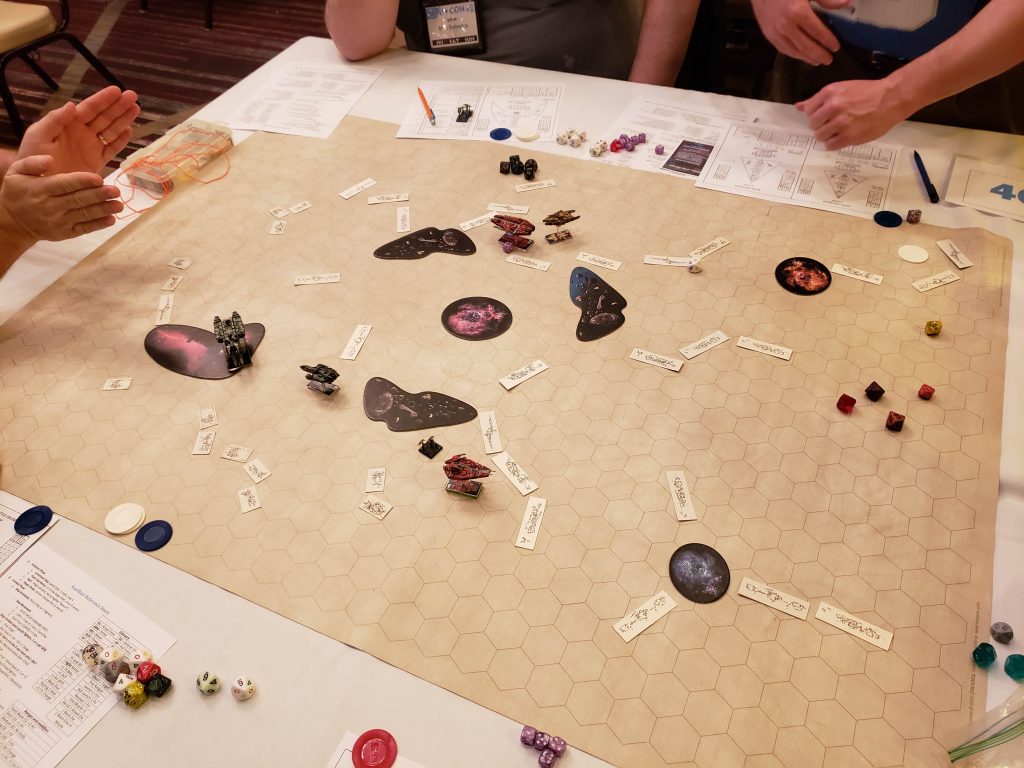
Farewells
I said my goodbyes to those who left before I did. I joined friends in the lounge to chat for a couple hours before I decided I better head home before dark. I really didn’t want to leave. I’m looking forward to next year.
You can hear the companion podcast here.

